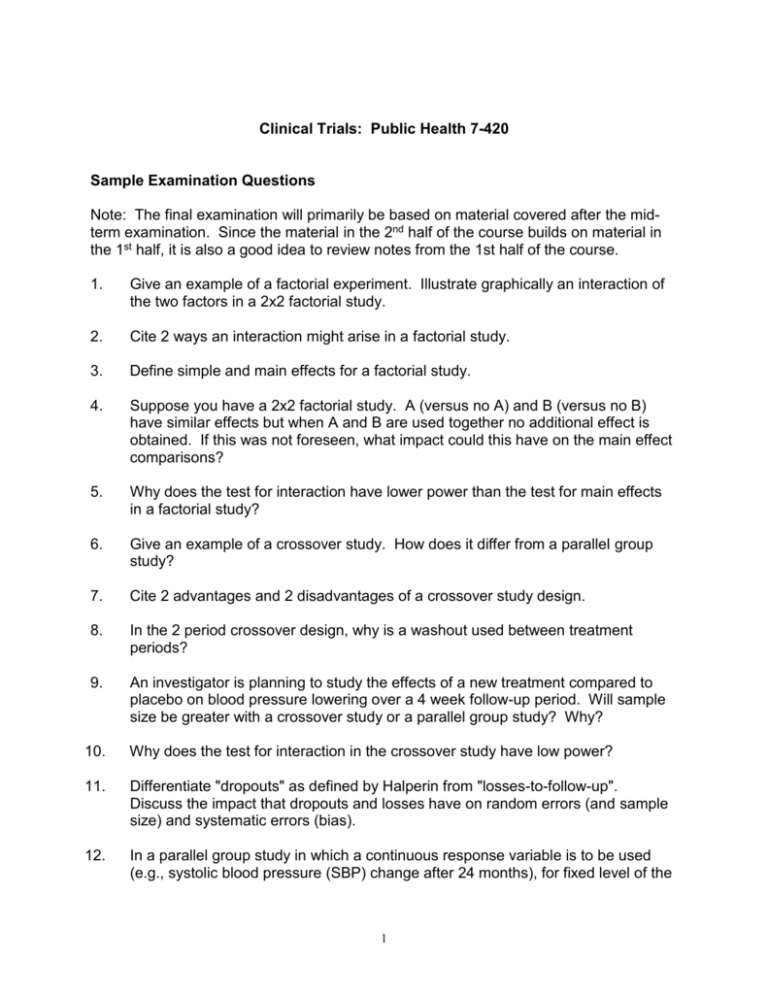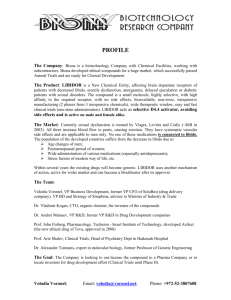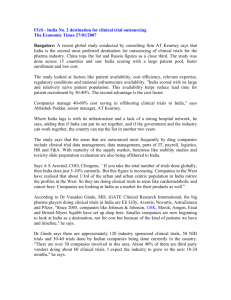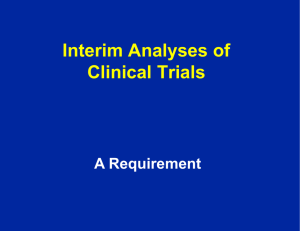Clinical Trials: Public Health 7-420 Sample Examination Questions
advertisement

Clinical Trials: Public Health 7-420 Sample Examination Questions Note: The final examination will primarily be based on material covered after the midterm examination. Since the material in the 2nd half of the course builds on material in the 1st half, it is also a good idea to review notes from the 1st half of the course. 1. Give an example of a factorial experiment. Illustrate graphically an interaction of the two factors in a 2x2 factorial study. 2. Cite 2 ways an interaction might arise in a factorial study. 3. Define simple and main effects for a factorial study. 4. Suppose you have a 2x2 factorial study. A (versus no A) and B (versus no B) have similar effects but when A and B are used together no additional effect is obtained. If this was not foreseen, what impact could this have on the main effect comparisons? 5. Why does the test for interaction have lower power than the test for main effects in a factorial study? 6. Give an example of a crossover study. How does it differ from a parallel group study? 7. Cite 2 advantages and 2 disadvantages of a crossover study design. 8. In the 2 period crossover design, why is a washout used between treatment periods? 9. An investigator is planning to study the effects of a new treatment compared to placebo on blood pressure lowering over a 4 week follow-up period. Will sample size be greater with a crossover study or a parallel group study? Why? 10. Why does the test for interaction in the crossover study have low power? 11. Differentiate "dropouts" as defined by Halperin from "losses-to-follow-up". Discuss the impact that dropouts and losses have on random errors (and sample size) and systematic errors (bias). 12. In a parallel group study in which a continuous response variable is to be used (e.g., systolic blood pressure (SBP) change after 24 months), for fixed level of the 1 hypothesized treatment effect (e.g., a difference of 5 mmHg), how does sample size vary according to the standard deviation for SBP change. 13. Define in a sentence or two the term, "lag", as used in the paper by Halperin. 14. Trials of statins to lower cholesterol indicate that the full effect of treatment on cardiovascular morbidity may not result occur until after 6 to 12 months of treatment. In secondary prevention trials of coronary heart disease (CHD), CHD event rates are likely to be greater early in follow-up compared to later in followup. On the other hand, in primary prevention trials CHD event rates may increase with longer follow-up. For fixed length of follow-up, in which trial is the 6-12 month lag going to have a greater effect on sample size? 15. Give an example of a clinical trial where consideration of lag would be important and one where it would not be. 16. Many investigators argue that in scientific papers more use should be made of confidence intervals (as opposed to P-values) and methods sections should include a discussion of Type I and Type II error rates. Why is this particularly important in "negative" trials (trials in which a significant treatment difference is not observed)? 17. Discuss why it is important in a clinical trial with a planned intention to treat analysis to consider compliance to treatment in the design? 18. In many trials the rate of non-compliance is greater early in follow-up as compared to later. If the expected event rate in the experimental treatment group is expected to increase over follow-up, what impact will this have on sample size as compared to a constant rate of non-compliance, assuming the cumulative noncompliance over all of follow-up is 30%? 19. A non-inferiority trial of a new treatment (treatment A) is being planned. The active control treatment (treatment B) to be used has been shown to be superior to no treatment – in an earlier trial the point estimate of the relative risk death for treatment B versus no treatment was 0.75. The investigators are planning to power their study to rule out a 25% higher death rate on treatment A versus B. Do you feel this is reasonable? 20. Why is an intention-to-treat analysis considered by some to be anti-conservative in a non-inferiority trial? 21. In a number of recent primary prevention trials the expected event rate in the control group was much less than originally planned. Discuss why this may have occurred. What impact on the experiment would you expect this to have? 2 22. Give an example of an "event-driven" trial. How does such a trial differ from a trial planned with a fixed follow-up period? 23. An event-driven trial of an experimental treatment that increases HDL cholesterol (a higher HDL cholesterol is associated with a lower risk of coronary disease). How will the required number of events vary with the hypothesized hazard ratio (or relative risk) for fixed type 1 and 2 errors? 24. Define "common closing date". 25. A simple adjustment for non-compliance to the experimental treatment in a clinical trial is to inflate the sample size by 1/ (1-d)2 where d = proportion of non-compliers. How was this inflation factor obtained? How does it differ from Halperin's approach? Is it more conservative in terms of sample size? 26. Give an example of scientific misconduct in clinical trials. 27. Define the term "dropin". Give an example of a clinical trial where "dropins" would have to be considered. 28. Differentiate a priori from a posteriori subgroup hypotheses. 29. What is meant by a treatment x subgroup interaction? Give an example. 30. State the null hypothesis corresponding to the treatment x subgroup interaction test. Use a subgroup comparing two treatments by gender to illustrate your answer. 31. Compare the goals of stratified analysis versus subgroup analysis. 32. Subgroup analyses should only be carried out on baseline variables that were used as stratification factors in the design. Do you agree? 33. What is the purpose of Data Monitoring Committees (DMCs) for clinical trials? 34. Why is it important to carry out interim analyses in clinical trials? 35. Why are statistical stopping guidelines used for trials? 36. Give an example of a stopping guideline. 37. A trial with 5 interim analyses is planned, at the 1st interim analysis are critical values greater using a Pocock or an O’Brien Fleming boundary? A Haybittle-Peto or O’Brien Fleming boundary? 3 38. Draw a 2-sided symmetric boundary for interim guidelines based on the O’Brien Fleming algorithm. 39. Give an example of a trial where the use of asymmetric boundaries should be considered. 40. The Lan-Demets spending function approach requires specification of the “information fraction” at each interim analysis. What does this mean? Give an example of how the information fraction might be defined in a event-driven trial with mortality as the outcome. 41. At a recent interim analysis for a HIV vaccine trial, the DSMB recommended the study be stopped for futility. What does that mean? 42. Differentiate conditional from unconditional power? 43. Be familiar with the use of Halperin's tables. 4







